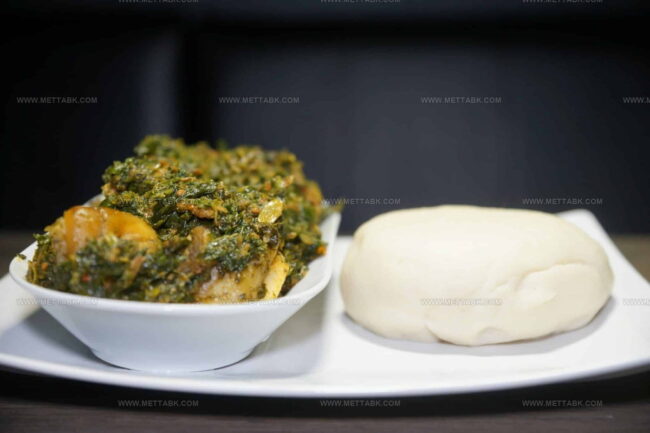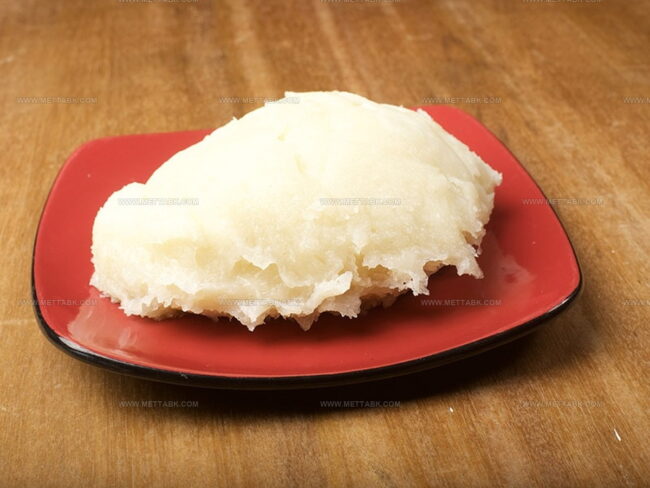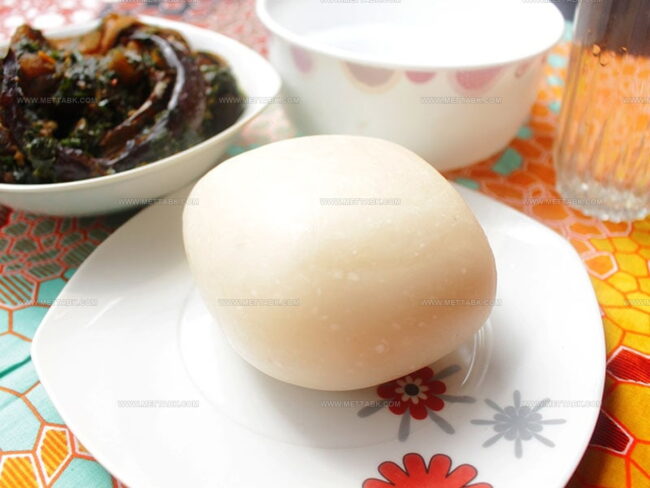What Does Fufu Taste Like? Unveiling This African Comfort Food
West African fufu, a beloved staple food, has intrigued food enthusiasts worldwide with its unique texture and cultural significance.
Culinary traditions often spark curiosity about unfamiliar dishes, especially when they differ dramatically from familiar cuisines.
This starchy, dough-like delicacy originated in regions where cassava and plantains thrive abundantly.
Countless people wonder about its flavor profile and how it compares to other foods they know.
Restaurants and home kitchens across Africa serve fufu as a fundamental component of meals, accompanying various sauces and stews.
The preparation method and accompanying ingredients play crucial roles in defining its overall taste experience.
Digging into the nuanced world of fufu promises a delightful journey through West African culinary heritage that will tantalize your taste buds and expand your gastronomic understanding.
Fufu: Simple Description
Fufu stands as a cherished dish from Africa. Puerto Rican Fufu differs with its denser texture and thicker crust.
Local chefs season it with strong spices and sometimes include crispy pork belly inside.
Describing Fufu's unique flavor proves challenging without actually sampling it.
Multiple eating styles exist for this special meal.
Derived from Twi language meaning mash or mix, Fufu connects West and Central African cultures along with Caribbean traditions.
Slightly tangy and soft, this dough emerges from boiled and mashed starchy ingredients like plantains, cassava, and yams - or sometimes blending multiple starches together.
Countries throughout West Africa craft distinct Fufu versions, with Nigeria, Cameroon, Togo, Benin, and Sierra Leone each presenting signature recipes.
Historical records suggest Ghana first created Fufu after Portuguese traders introduced cassava during 16th-century interactions.
What Fufu Tastes Like
Fufu looks and feels similar to mashed potatoes.
Soft and creamy or slightly spongy, this dish might remind you of a buttery treat.
While it can be enjoyed alone, fufu shines when mixed with a tasty sauce.
Soups and stews help show off its unique flavor profile.
Making fufu involves many ingredients, which create different textures and tastes.
Typically, the flour-based food has a mild flavor.
Subtle hints of bitterness, sourness, and saltiness come through when you eat it.
Some say it tastes like a blend between white rice and potatoes.
Its light taste makes it perfect for pairing with bold dishes like spicy Ghanaian chicken soup.
Travelers exploring African cuisine should definitely sample this classic dish.
Fufu serves as an important food staple across many regions.
Packed with carbohydrates, it provides quick energy and comes in multiple variations.
Visitors can enjoy this simple yet satisfying meal that has nourished communities for generations.
Types Of Fufu Explained
Fufu serves as more than just food - it represents connection, history, and cultural pride.
Discover delicious variations that highlight local flavors and cooking techniques across the continent.
Cassava
Cassava serves as a key ingredient for creating Fufu.
West African nations like Liberia, Sierra Leone, Ivory Coast, Nigeria, Ghana, Togo, and Benin enjoy this dish.
Caribbean regions also appreciate Fufu in their meals.
Fermented cassava Fufu pairs wonderfully with various stews:
Matching Fufu with any desired stew results in a delightful meal.
Flavors blend perfectly, making each bite satisfying and tasty.
Fufu
Fufu, called eba in Nigeria, comes from dried and ground cassava.
Gari creates a rougher feel compared to regular cassava fufu.
Small hints of tartness and sourness fill its taste profile.
West African kitchens in Nigeria, Ghana, Cameroon, Togo, Benin, Sierra Leone, and neighboring regions enjoy this staple dish.
Pounded Yam Dish
Fufu crafted from yam flour simmers on stoves with steaming water.
Strong arms work hard to mash the mixture into smooth, creamy consistency similar to mashed potatoes.
Serious muscle power helps create this West African staple dish that rewards effort with incredible taste.
Pairing this soft white food with vegetable or peanut stew makes each bite more satisfying.
Egusi soup alongside pounded yam offers an incredible meal experience everyone should sample during their lifetime.
Cassava Or Black Yam Powder
Black yam or cassava fufu stands out with its brown or off-white look and thick, slightly sticky feel.
Locals call this dish kokanee in Ghana and amala in Nigeria.
Many find its taste something they must learn to enjoy.
West African regions serve this fufu with different traditional soups.
Ghanaians often pair it with groundnut or palm oil soup.
Southern Nigerian Yoruba communities mix fufu with ewedu stew made from corchorus leaves.
Cross River State's Efik groups enjoy fufu alongside edikaikong green leaf soup or bush mango soup.
Matching this dense food with rich sauces brings out its special character and allows cooks to showcase regional cooking styles.
How To Prepare And Use Fufu
Fufu slides down smoothly when mixed with soup, skipping the chewing process.
West African kitchens know this dish requires special skill to consume correctly.
Mashed yam with a peanut base creates its unique texture, feeling heavier than standard mashed potatoes.
Vegetable soup serves as the ideal companion for this traditional meal.
Curious cooks might want to search online for detailed preparation methods.
Swallowing Fufu works best when coated in soup, making the process easier.
Dense and heavy, this dish challenges newcomers with its thick consistency.
Pounding in a mortar helps create the right texture.
Salt and pepper can enhance the mashed yam's flavor, making each bite more enjoyable.
Meat, fish, and vegetables complement Fufu's taste beautifully.
Strong and complex flavors work wonderfully with this traditional dish.
Creating Fufu starts with grinding specific ingredients into smooth dough.
Careful cooking softens ingredients before mashing in a traditional mortar.
Cooks shape the mixture into neat balls.
Soup or stew provides the most common serving method, though multiple preparation techniques exist for this classic West African staple.
Popular Soups and Stews Traditionally Eaten With Fufu
Fufu is a soft, starchy staple in many West and Central African cuisines, and it’s usually enjoyed with hearty soups and stews that are full of flavor and tradition:
Do You Chew Fufu Or Swallow It?
Fufu serves as a staple meal in many African countries, often enjoyed alongside hearty soups and consumed whole.
Newcomers might find this traditional dish somewhat challenging at first taste.
Families typically introduce fufu to children from a very early age, helping them connect with their cultural roots.
Fufu itself doesn't have a strong flavor on its own, which makes its texture the main focus.
Since the consistency is quite dense and smooth, most people prefer to swallow it with soup rather than chew.
Chewing remains an option for those who want to experience fufu differently.
Small pieces can be broken off and dipped generously in soup, allowing you to savor the combined flavors and textures more completely.
Can Eating Fufu Make You Gain Weight?
Yes, fufu dishes pack a significant carbohydrate punch, with some servings containing around 100 grams of carbs.
These carbohydrates offer essential energy for young children.
Adults without physically demanding jobs will struggle to burn off all the carbs and calories in this meal.
Weight gain becomes an inevitable outcome, slowly creeping up and becoming more apparent as years pass.
Most African soups are rich in fat, adding to the high-carb, high-fat profile of the dish.
Frequent consumption of fufu several times weekly could lead to obesity and various health complications.
Is Fufu Served Warm Or Cold?
Fufu ingredients create a variety of tastes and textures.
Flour-based dishes often seem plain at first.
Hints of bitterness, sourness, and salt peek through its basic profile.
Flavors might remind you of white rice mixed with potatoes.
This light-tasting food works best alongside rich meals like spicy Ghanaian chicken soup.
Travelers exploring African regions should sample this classic dish.
Fufu serves as more than a simple snack - it stands as a key meal across many African countries.
Carbohydrate-packed and energizing, fufu helps people stay full and active throughout their day.
Subtle flavor makes it an excellent partner for stronger, more intense dishes that bring excitement to the plate.
Best Ways To Keep Fufu Fresh
Storing Fufu needs careful attention to prevent spoiling.
Cold storage works best for keeping this dish safe to eat.
Place fresh or cooked Fufu into sturdy containers with tight-fitting lids to maintain its quality.
Refrigeration helps protect the food from going bad quickly.
Storing Fufu in the fridge requires some simple steps:
Freezing offers another good method for longer storage.
Wrap Fufu tightly in special freezer paper and label it well before putting it in cold storage.
When you want to eat stored Fufu, microwave it for one minute to warm it up gently.
This helps bring the dish back to a nice eating temperature without risking spoilage.





Nate Harper
Founder & Recipe Curator
Expertise
Single-Recipe Development, Farm-to-Table Cooking, Seasonal Menu Planning, Culinary Storytelling, Home Kitchen Innovation
Education
Cascade Culinary Institute – Central Oregon Community College
Certificate in Culinary Arts
Focus: Farm-to-table cuisine, sustainable cooking practices, and seasonal recipe creation.
Nate studied under experienced chefs who emphasized local sourcing, minimal waste, and building recipes from fresh, simple ingredients.
Nate Harper is the founder and creative force behind Make, Take, Bake. Raised in the wild beauty of Oregon’s high desert, Nate grew up surrounded by family gardens, farmers’ markets, and home kitchens that celebrated the seasons.
His early love for simple, honest food evolved into a professional passion when he attended Cascade Culinary Institute, where he sharpened his skills in creating recipes that are sustainable, satisfying, and made for everyday life.
Nate’s goal is to make cooking feel accessible, free of fuss, and full of flavor. He believes a single, thoughtfully built dish can stand alone, and sometimes even steal the show.